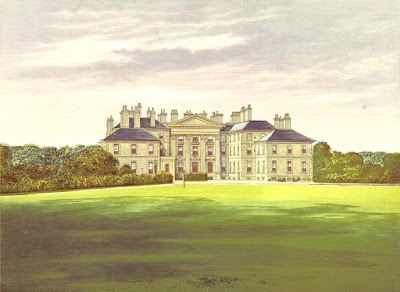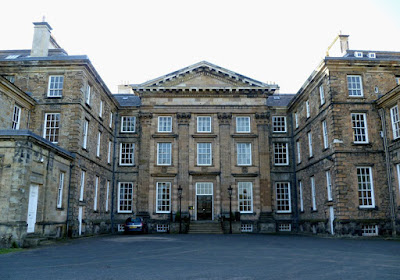 |
| A coloured print of Dalkeith Palace from 1880. Source : Wikipedia |
The story of the little known but palatial Dalkeith Palace in Midlothian Scotland is worth relating, simply because of what it had once been. Rather sadly, the fine contents parted company with the Palace 103 years ago and are now, although still both family owned, irrevocably separated. How and why will be detailed further on in this blog.
 |
| The Gallery, taken 1911. Source : Country Life |
But first we need to travel back to 1701 when Anne, Duchess of Buccleugh (and widow of King Charles the Second's illegitimate son, the Duke of Monmouth), returned to Scotland after many years at Court to oversee the large family estates.
 |
| The Staircase Hall and Marble Staircase, taken 1911. The 1828 marble statue of the Duke of Wellington by Thomas Campbell still resides here today. Source : Country Life |
It was Duchess Anne who, in 1702, engaged the noted Scottish Architect James Smith to rebuild the old castle at Dalkeith, just south of Edinburgh. A Palladian fronticepiece now graced the handsome new building but what Smith also created inside, and under the specific direction of the Duchess, truly set out to impress. The baroque decorations were magnificent but the frequent and beautiful use of marble for architectural work within the house was, then and now, almost unique in Scotland. This work included not only the marble staircase but a marble screen with Corinthian columns, marble door casings, chimney pieces and fireplaces, with marble tables to match. Smith created a baroque masterpiece.
 |
| A pink and white carved chimney piece by Grinling Gibbons located in Duchess Anne's "Petit Apartements". Taken 1911 Source : Country Life |
Naturally the standard of furniture and furnishings were equally impressive and this can be confirmed by the fact that the majority of the furniture from the formal rooms survive today.
Later Dukes of Buccleugh were responsible for the landscaped park which surrounds the Palace, including the striking single arch "Montagu Bridge" designed and built by Robert Adam in 1792.
 |
| The Montagu Bridge by William Adam and framing the rear of Dalkeith Palace. Source : WKU Libraries |
Dalkeith Palace had a number of memorable and famous visitors. Firstly, Prince Charles Edward Stuart stayed for two nights at Dalkeith Palace in 1745 during his ill fated attempt to regain the English throne for his Father. Duke Francis, a Hanoverian supporter, was forced to provide hospitality to the 'Young Pretender' and with troops supporting the Prince encamped nearby one would not have dared refuse. Francis still generously plied the Prince with chicken, duck, oysters and brandy. I wonder what conversation passed between the Duke and The Prince at the dinner table?
 |
| A 19th century 'Mauchline Ware' paper knife with a printed image of Dalkeith Palace. This is known as 'Transfer Ware' From my own collection. |
Then in 1822, and due to the "long neglected" condition of the Palace of Holyrood in Edinburgh, King George IV used Dalkeith Palace for two weeks as his "pied-à-terre", being the guest of Walter, the young 16 year old Duke of Buccleugh. During this momentous state visit to Scotland, George would drive out daily to drawing rooms, balls, theatre performances, banquets and dances but much entertaining also took place at Dalkeith. Lamps illuminated the entire road at night between Edinburgh and Dalkeith.
 |
| A close up of the above 'transfer ware' image of Dalkeith Palace. From my own collection. |
The Royal chefs took over the Dalkeith kitchens with the King being served by his own Butlers. But keeping an eye on his generous - but young - host, the King once protested when the Duke was offered a glass of the King's liquer, "No! No! It is too strong for his Grace to drink." At night the King slept "in a domed Polonaise bed amid the luxury of Dalkeith", the bed having been especially made for him.
 |
| The Entrance Front, Dalkeith Palace, 1984. Source : Country Life |
Another significant visit took place during the state visit of Queen Victoria to Scotland in 1842. Due to a sudden outbreak of scarlet fever at the Palace of Holyroodhouse, the Queen and Prince Albert resided for five days in Dalkeith Palace with the Queen's leveés being held in the Gallery.
 |
| Dalkeith Palace today. Source : Wikipedia Commons |
While photographed by "Country Life" in 1911 and 1912, it is indeed unfortunate that the Palace interiors with the original furniture and furnishings "in situ", were not fully recorded. For in 1914 the Buccleugh family formally "closed" Dalkeith Palace, transferring the sumptuous contents primarily to their country seat of Drumlanrig Castle in Dumfries and Galloway. The latter has been further enriched by furnishings from the demolished London family seat of Montagu House in Whitehall. For the duration of 'The Great War' the estate at Dalkeith was used to house soldiers.
 |
| Dalkeith Palace today. Source : Wikipedia Commons |
Thus it is fortunate that despite a variety of subsequent uses, including housing Polish troops during World War Two and since 1984 being occupied by the European Study Centre for the University of Wisconsin USA, the Palace itself has survived the vicissitudes of time, not to mention death duties and the huge cost of maintaining an old building. Sentiment may have played a part in its survival. In the decades following The Great War grand family homes often had little appeal and were deeply unfashionable. Finding other uses for the palace most likely saved it. Ownership of Dalkeith Palace is, to their credit, still retained by the Dukes of Buccleugh and Queensberry, and the building is kept in good repair. The last major work involved fitting a new roof in 2008. Bearing in mind the fate of unfashionable and unwanted architectural masterpieces such as Hamilton Palace, the Montagu - Douglas - Scott family have been excellent guardians of their heritage.
 |
| The Marble Hall today. Source : University of Wisconson in Scotland |
An impression of the rich furniture and furnishing which once graced the Palace rooms may today be gained by visiting Drumlanrig Castle. But both Palace and contents are indeed now irrevocably separated and were an attempt ever made to rejoin the two this would considerably diminish the now opulent interiors at Drumlanrig.
 |
| The Entrance Hall today. Source : University of Wisconson in Scotland |
The Dalkeith Palace grounds have been open to the public since 1975 and upwards of 80 students now occupy the Palace during the term semesters.
 |
| The now semi-ruinous conservatory in the Palace grounds. It has now become what one would term a "folly". Source : British Listed Buildings |
Bibliography :
- "Scottish Houses and Gardens", by Ian Gow (Country Life publication)
- "George IV" by Christopher Hibbert
- Various Internet resources

No comments:
Post a Comment